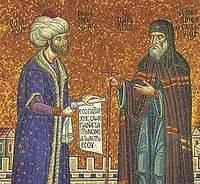Schism: Fall of Constantinople
WEEK 3: THE FALL OF CONSTANTINOPLE
Historical perspective:
Review last week’s lesson with a special view to the 4th Crusade and the sack of Constantinople. How did this make things easy for the Turks? Why did it take them 200 years, then?
The act itself:
In 1451 the Moslem Turks had a new king, Mehmet. Mehmet was only 19 years old when he ascended the throne. Mehmet had only one idea in his mind; he told his generals, “There is only one thing I want: Give me Constantinople!” Mehmet was sure he could conquer the great capital of the Byzantine Empire. So, he gathered a great army to prepare for his attack, and built huge numbers of ships until he had the greatest navy in the East. He also built a great cannon, so big that it had to be drawn by 60 oxen and loaded by 200 men. The cannon was a new weapon; could the walls of the city withstand it?
Constantinople, weakened by the Crusaders, had only an army of 8000 soldiers and 30 ships. But, the city was built on a peninsula -- a strip of land surrounded on three sides by the sea. There were huge walls around the whole city; these had held off many Moslem armies over hundreds of years. A huge chain stretched across the Golden Horn, protecting the city walls and the city’s navy.
 Mehmet moved his army into place on the day after Easter in 1453. He asked the Emperor Constantine XI to surrender and give the city to the Moslems; the Emperor would not give up that easily. Soon the huge cannons were pounding the walls, but the walls held. Mehmet’s ships held the waterways and kept food from reaching the city. But, he could not enter the city. Finally, Mehmet built a huge pontoon bridge across the water. Now his armies could attack from both sides. The Christians were hungry and weak. But, they continued to fight.
Mehmet moved his army into place on the day after Easter in 1453. He asked the Emperor Constantine XI to surrender and give the city to the Moslems; the Emperor would not give up that easily. Soon the huge cannons were pounding the walls, but the walls held. Mehmet’s ships held the waterways and kept food from reaching the city. But, he could not enter the city. Finally, Mehmet built a huge pontoon bridge across the water. Now his armies could attack from both sides. The Christians were hungry and weak. But, they continued to fight.
Finally, the Turks prepared for their last big attack. The Emperor spoke to his people and told them to be ready to die for their Lord and their homes. Then the Christians all took communion in the many churches of the city and went to the walls to be ready for battle. In the middle of the night, Mehmet attacked. The thick walls of the city were no match for the huge cannon. The first two waves of attackers were repulsed, but now the defenders were exhausted. Mehmet sent in his favored corps of fresh soldiers. This time his troops rushed up the walls of the city and charged into Constantinople. Recent evidence even indicates that perhaps a back gate was also left open for the invaders – by accident or as a betrayal? Emperor Constantine was killed. For three days, the Moslems sacked the city, killing all Christians they could find, stripping all the riches of the homes and churches, and burning whole sections of the wonderful city. The great Church of St. Sophia was renamed a Moslem mosque. The Byzantine Empire, outliving Rome by a thousand years, was finally defeated.
Aftermath:
- Mehmet installed himself as ruler, rebuilt the city, renamed it Istanbul, and made it the capital of his Turkish Empire.
- Mehmet invited the Christians to return to their desolate home and allowed them to worship in their own churches. Many had been taken captive or fled to Genoa or Venice. They were afraid to return, but were promised freedom from massacre.
- Mehmet installed a Greek monk, George Scholarius, as Patriarch and instituted a Holy Synod to hear any civil cases involving only Christians.
- The Ottoman Empire lasted until 1923, but Turkey, as a modern state, is Moslem to this day.
- With the exception of Russia, the Eastern Orthodox Church fell behind a Moslem “curtain”.
- Thousands of Christians fled to the West, still in the “Dark Ages”. Soon followed the Renaissance, the rebirth of culture and education and art in the West – perhaps the lasting gift of these Eastern immigrants.
- The Eastern trade routes to India and China, opened by Marco Polo 300 years before, were now closed. Shortly after the fall of Constantinople, the countries of Europe began seeking a route to the east by ship. Italians, Portuguese, and Spanish ships went in search. So…how was the Fall of Constantinople in 1453 tied to the discovery of the New World by Columbus in 1492? WOW!
Quiz Questions:
First review the quiz questions from the previous two weeks of the unit. Have the students met all the objectives of the unit?
There are two questions today: List all the major factors leading to the Fall of Constantinople, beginning with the Fall of Rome, in chronological order. And discuss the consequences of the Fall of Constantinople, especially as regards to the Orthodox Church and to the United States today.